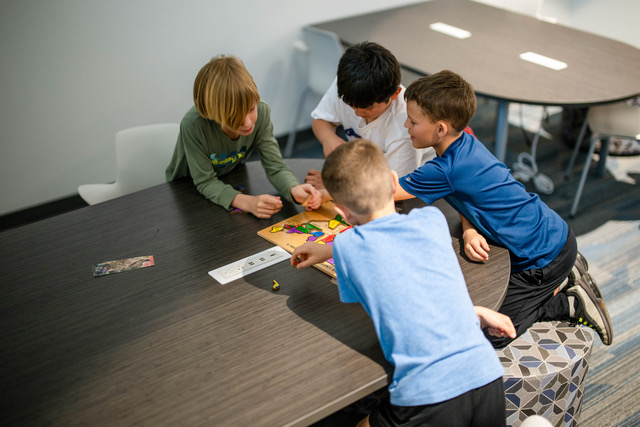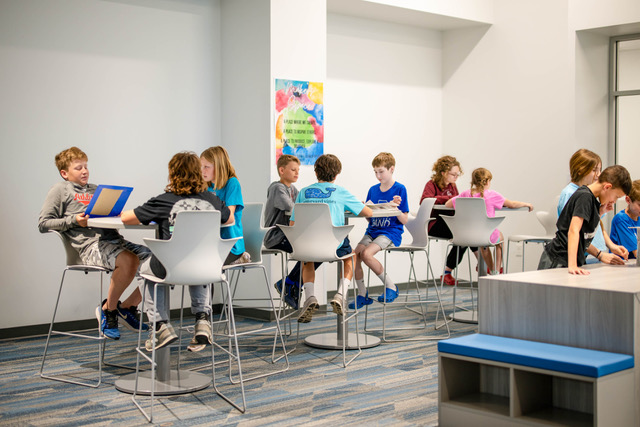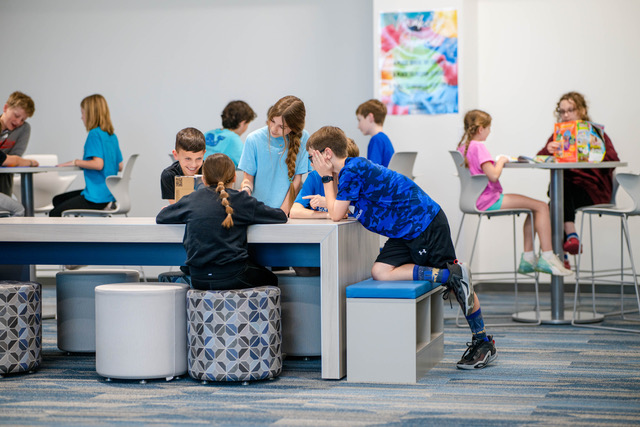5 Tips for New Teachers and Their Administrators on Classroom Design
- By Robert Dillon, Christina Counts
- 11/19/24
Recently, several school visits early in the academic year highlighted how many first-year teachers struggle to set up their classrooms effectively. It's evident that more can be done to better support them from the start, particularly in the area of classroom design.
Classroom design, right down to the selection and placement of the furniture, is foundational to everything that comes later. Student engagement is going to look different in a room with desks arranged in a circle than in a room where they're all in neat rows facing the teacher. A rocker chair or balancing stool becomes a key classroom management tool when it helps a student with the wiggles get some energy out instead of disrupting the class.
New teachers deserve all the support they can get, and with the right design, the classroom itself can offer a bit of that support. Here are five tips to help first year teachers set themselves up for success, along with suggestions for administrators to be sure they're headed down the right path.
 Photo courtesy of MiEN
Photo courtesy of MiEN
Stick to Principles
Teacher preparation programs don't always require teacher candidates to spend a lot of time learning how to properly set up a classroom, so unfortunately you may have to go it alone when you get to your first class. Do a little research into classroom design. The Association for Learning Environments (A4LE) or YouTube resources provide a wealth of useful information. You don't have to become an expert, but four or five research based principles that align to your new school's approach to learning will offer quite a bit of guidance as you set up your students' new learning space.
Administrators can help new teachers by providing those principles for them. Create a document that lays out your district’s or school’s principles around learning spaces and explaining what you believe a school is. Without guiding principles grounded in research, new teachers are likely to set up their classroom the way their own teachers set them up or to follow someone they saw on social media because it looked nice, or a lot of people were talking about it.
Remember Classes Are Works in Progress
Get your classroom ready for students, but don't get too attached to any of your ideas. To create truly student-centered classrooms, we need to be designing with students, not just for them. Be sure you are gathering student feedback two or three weeks into the year and adapting your room to student needs as possible.
Administrators can help by reminding teachers that the initial set up is only a starting point. That means letting them redesign the classroom as necessary, but it may also mean that you sit down with some of your design guru teachers to come up with a short questionnaire designed to elicit self-reflection about the physical space students are learning in or even a survey for teachers to give their students a few weeks after school starts or periodically throughout the year.
 Photo courtesy of MiEN
Photo courtesy of MiEN
Get Outside Your Own Room
As a new teacher, it's easy to look next door to someone who is teaching the same grade or content area and follow their lead. That's not the worst place to start, but there is a good chance that the veteran teacher doesn't have a much stronger foundation in classroom design beneath their years of experience.
Try to visit several classrooms in your new school or district and don't be afraid to ask questions. By visiting several classrooms, you may notice themes related to pedagogy emerging or common routines that will be familiar to your students because they are common in your building.
Administrators can encourage this kind of community learning by giving new teachers a few extra days to set up their classrooms and encouraging them to walk around campus visiting veteran teachers' classes as they set up. Or try pairing your first-year teachers with their more experienced colleagues so they each have an extra pair of hands to do the work, and the established teacher can provide support and guidance specifically aligned to your district's vision.
Practice Your Routines and Processes
Active classrooms require more processes and routines than traditional classrooms because, for example, students with assigned seats don't need a process for wisely choosing seats each day. Student centered classrooms mean students are making a lot more choices, so it's important to think about how you will facilitate those moments and bake routines into them so that they are smooth and efficient. One good place to start is by thinking about transitions. Traditional classrooms have routines to help students transition from class to lunch or recess, and you will likely need to establish routines to transition the classroom from a lecture format to a group work arrangement for furniture. Think about how you will structure those routines ahead of time and practice them with your students at the beginning of the year.
Administrators can help new teachers establish appropriate routines by asking established educators what routines have helped their students. Giving them examples of how their more experienced colleagues structure their day will give them practical solutions they can adopt themselves, but hopefully there are a variety of routines that also demonstrate that there is no "right way" to do things for every teacher and group of students.
 Photo courtesy of MiEN
Photo courtesy of MiEN
Don't Be Afraid to Fail Forward
As a new teacher it can be scary to try new things out, but without risk taking, we learn very little. Be sure you are trying techniques and tactics that are backed by research, but don't be afraid to experiment! Try one or two new things at a time so that you can understand and, hopefully, correct for any challenges that arise.
Administrators can support new and veteran teachers by encouraging a "fail forward" culture. We ask our students to adopt growth mindsets and to learn from failure, and this is a perfect opportunity to model that attitude from classroom teachers through the administration.
Teachers, and especially new teachers, can be somewhat risk averse and hesitant to try ideas that aren't time tested and approved. Be sure to let them know that it's okay if the class is a little rowdier or if some change simply doesn't work out.
If you're providing new teachers with a list of principles as I suggested above, consider making one of them something like, "We have a fail forward mentality" to let them know teachers are encouraged to try new instructional strategies or types of lessons or whatever it may be. You may have to repeat this weekly. You may have to mention it informally. It's worth baking into your normal communication and a part of your school's identity because if your teachers aren't trying new things with their students, they probably aren't growing much as educators.
We know that for students to learn, they have to be vulnerable enough to take risks and to fail sometimes so that they can reflect on their missteps and try again until they succeed. The same is true of teachers and there's no better way to demonstrate that it's okay to try and fail and try again than to make the very environment students are learning in itself a work in progress.